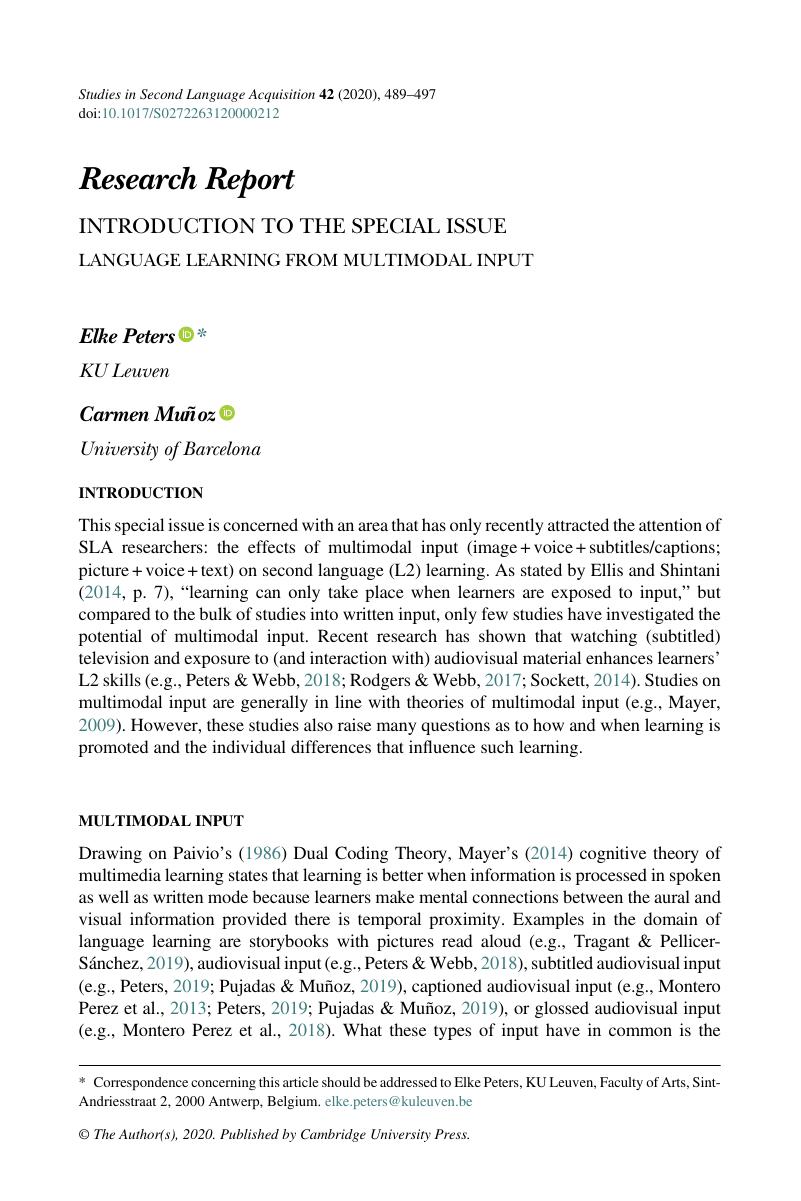Crossref Citations
This article has been cited by the following publications. This list is generated based on data provided by Crossref.
Montero Perez, Maribel
2020.
MULTIMODAL INPUT IN SLA RESEARCH.
Studies in Second Language Acquisition,
Vol. 42,
Issue. 3,
p.
653.
Ambrosini, Maria Vittoria
and
Della Putta, Paolo
2021.
Problemi di apprendimento di tre perifrasi fra spagnolo e italiano. Osservazioni acquisizionali e proposte pedagogiche.
Cuadernos de Filología Italiana,
Vol. 28,
Issue. ,
p.
11.
Pellicer-Sánchez, Ana
2022.
Multimodal reading and second language learning.
ITL - International Journal of Applied Linguistics,
Vol. 173,
Issue. 1,
p.
2.
Shaojie, Tan
Samad, Arshad Abd
and
Ismail, Lilliati
2022.
Systematic literature review on audio-visual multimodal input in listening comprehension.
Frontiers in Psychology,
Vol. 13,
Issue. ,
Cheng, Yidong
Wang, Yi
and
Sun, Le
2022.
Movie Special Effects Processing Based on Computer Imaging Technology.
Scientific Programming,
Vol. 2022,
Issue. ,
p.
1.
Wang, Yi
Cheng, Yidong
and
Zhou, Mu
2022.
The Application of the Combination of Virtual and Reality in the Film Space Performance.
Wireless Communications and Mobile Computing,
Vol. 2022,
Issue. ,
p.
1.
Guo, Yong
Zhong, Chan
and
Li, Qiangyi
2022.
Motion Capture Technology and Its Applications in Film and Television Animation.
Advances in Multimedia,
Vol. 2022,
Issue. ,
p.
1.
Montero Perez, Maribel
2022.
Second or foreign language learning through watching audio-visual input and the role of on-screen text.
Language Teaching,
Vol. 55,
Issue. 2,
p.
163.
Dang, Thi Ngoc Yen
Lu, Cailing
and
Webb, Stuart
2022.
INCIDENTAL LEARNING OF SINGLE WORDS AND COLLOCATIONS THROUGH VIEWING AN ACADEMIC LECTURE.
Studies in Second Language Acquisition,
Vol. 44,
Issue. 3,
p.
708.
Hu, Zhiyi
and
Liu, Liangfang
2023.
Research on the application of virtual reality technology in 3D animation creation.
Optik,
Vol. 272,
Issue. ,
p.
170274.
Gilabert, Roger
2023.
Where SLA and Language Education Meet: The Transfer from Task-Based Needs Analysis to Task Design.
Education Sciences,
Vol. 13,
Issue. 10,
p.
1015.
Vu, Duy Van
Noreillie, Ann-Sophie
and
Peters, Elke
2023.
Incidental collocation learning from reading-while-listening and captioned TV viewing and predictors of learning gains.
Language Teaching Research,
p.
136216882211510.
Reynolds, Barry Lee
2023.
Vocabulary Learning in the Wild.
p.
1.
Pizarro Pedraza, Andrea
Suñer, Ferran
and
De Cock, Barbara
2024.
Beyond Bleeps and Bounds: The Role of Individual Differences in Understanding Taboo Language from TV Series in the L2.
Languages,
Vol. 9,
Issue. 3,
p.
74.






